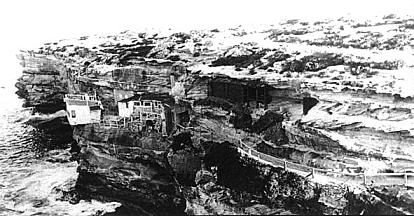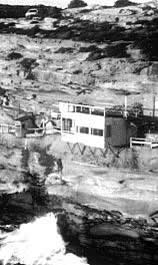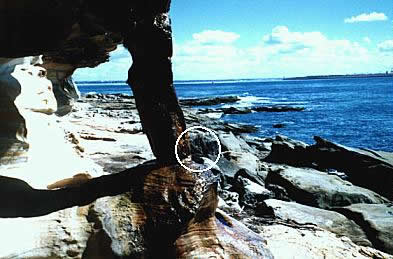 • Tourism
• Tourism
• Camping
• Cliff Dwellers
• The Reserve
• Cricket
• NPWS
• Field Studies Centre
|
Squatters and Campers |
Tabbigai Cliff Dwellers
Tabbigai Cliffs, located about 1km south of Cape Solander, were home to men such as Bert Adamson, Gordon Donovan, and Sid James, who have left a record of their experiences. They lived there, happily, from the 1920s until their cliff houses were demolished in 1974. Permissive occupants at Tabbigai, not squatters, they paid an annual fee to the Lands Department and also paid Council rates for the right to occupy their precarious ledge. The trio had camped and fished from a somewhat sheltered, wide ledge since they were in their teens. Most cliff houses such as theirs were built during the Depression years of the late 1920s and the 1930s. |
 |
| During the 1930s the three fishing mates constructed a comfortable home and gradually added modern conveniences and extra rooms. They scraped, sealed and painted the inside cave walls and extended the roof beyond the cliff face to protect them from gales and rain. |
  |
Passageways and tunnels were dug through the rock. Water came from a natural spring. They used kerosene lights and refrigerators; a generator supplied their electricity and they even carpeted their floors. Included in the complex was a guest flat! They considered themselves Australia's luckiest citizens, living in their own idea of Heaven, dropping a fishing line out of the loungeroom window to catch breakfast, lunch or dinner. The Aborigines never had it as good as this.
In 1961 the Lands Department reviewed the permissive occupancy agreements and ordered the cliff dwellers and permanent Reserve campers to leave. Two of the mates grudgingly complied while pointing out that they paid their rates to the Sutherland Shire Council; Bert, however, refused to budge and he might well have lived out his days there had it not been for vandals who set fire to a stolen car and pushed it over the cliff so that it hit the roof of the cliff house and its exploding petrol tank demolished the house in a blaze of fire, razing 40 years of idyllic existence. Bert was then 75 years old; he left reluctantly to live in highly urbanised inner Sydney.
Tabbigai was not the only cliff-face dwelling area, though it was the most substantial, the most comfortable and the most longstanding. There were camps all along the cliffs overhanging the ocean. The cliff dwellers kept an eye on the park visitors and deterred vandalism. There was one such camp at Inscription Point beside the Natural Arch where campers gouged out a little chamber about 12 inches long to catch fresh drinking water. That trough fills with fresh water to this day. |
 |
| Most of the camps in the Reserve were of a permanent nature and, like the cliff houses, were built during the Great Depression or soon after the Second World War. Thomas Holt Jnr allowed camps on his land at Boat Harbour for payment of a fee. Boat Harbour became a 'Happy Valley' shantytown. In 1922 it was reported that there were as many as fifteen humpies on one piece of land there. |
 |
| top of page |
|
| |
|



